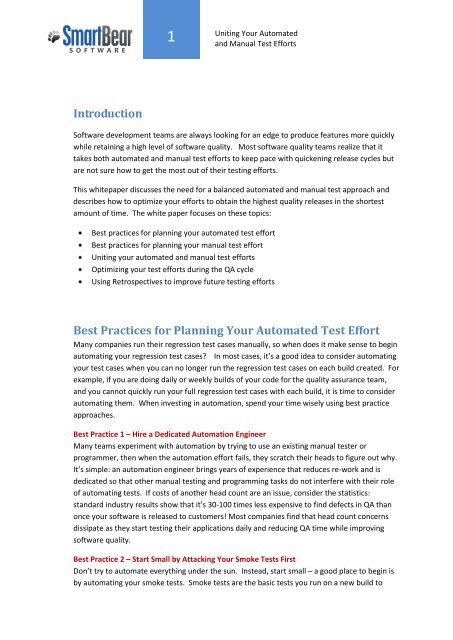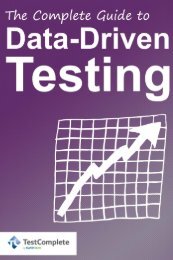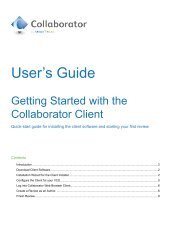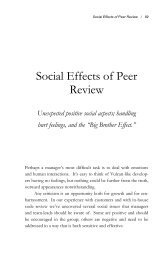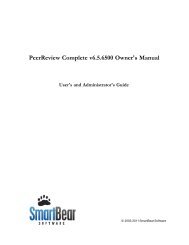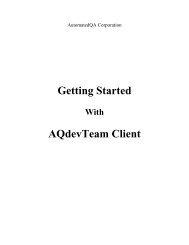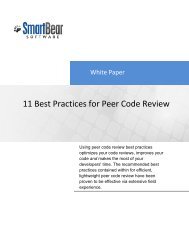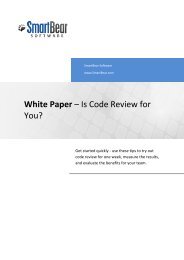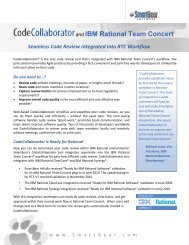Uniting Your Automated and Manual Test Efforts - SmartBear Support
Uniting Your Automated and Manual Test Efforts - SmartBear Support
Uniting Your Automated and Manual Test Efforts - SmartBear Support
Create successful ePaper yourself
Turn your PDF publications into a flip-book with our unique Google optimized e-Paper software.
Introduction<br />
1<br />
<strong>Uniting</strong> <strong>Your</strong> <strong>Automated</strong><br />
<strong>and</strong> <strong>Manual</strong> <strong>Test</strong> <strong>Efforts</strong><br />
Software development teams are always looking for an edge to produce features more quickly<br />
while retaining a high level of software quality. Most software quality teams realize that it<br />
takes both automated <strong>and</strong> manual test efforts to keep pace with quickening release cycles but<br />
are not sure how to get the most out of their testing efforts.<br />
This whitepaper discusses the need for a balanced automated <strong>and</strong> manual test approach <strong>and</strong><br />
describes how to optimize your efforts to obtain the highest quality releases in the shortest<br />
amount of time. The white paper focuses on these topics:<br />
Best practices for planning your automated test effort<br />
Best practices for planning your manual test effort<br />
<strong>Uniting</strong> your automated <strong>and</strong> manual test efforts<br />
Optimizing your test efforts during the QA cycle<br />
Using Retrospectives to improve future testing efforts<br />
Best Practices for Planning <strong>Your</strong> <strong>Automated</strong> <strong>Test</strong> Effort<br />
Many companies run their regression test cases manually, so when does it make sense to begin<br />
automating your regression test cases? In most cases, it’s a good idea to consider automating<br />
your test cases when you can no longer run the regression test cases on each build created. For<br />
example, if you are doing daily or weekly builds of your code for the quality assurance team,<br />
<strong>and</strong> you cannot quickly run your full regression test cases with each build, it is time to consider<br />
automating them. When investing in automation, spend your time wisely using best practice<br />
approaches.<br />
Best Practice 1 – Hire a Dedicated Automation Engineer<br />
Many teams experiment with automation by trying to use an existing manual tester or<br />
programmer, then when the automation effort fails, they scratch their heads to figure out why.<br />
It’s simple: an automation engineer brings years of experience that reduces re-work <strong>and</strong> is<br />
dedicated so that other manual testing <strong>and</strong> programming tasks do not interfere with their role<br />
of automating tests. If costs of another head count are an issue, consider the statistics:<br />
st<strong>and</strong>ard industry results show that it’s 30-100 times less expensive to find defects in QA than<br />
once your software is released to customers! Most companies find that head count concerns<br />
dissipate as they start testing their applications daily <strong>and</strong> reducing QA time while improving<br />
software quality.<br />
Best Practice 2 – Start Small by Attacking <strong>Your</strong> Smoke <strong>Test</strong>s First<br />
Don’t try to automate everything under the sun. Instead, start small – a good place to begin is<br />
by automating your smoke tests. Smoke tests are the basic tests you run on a new build to


